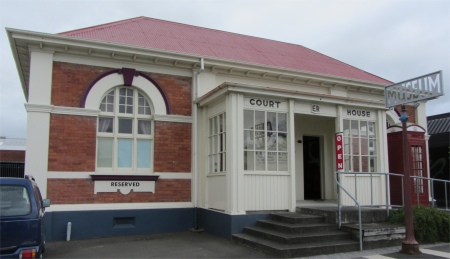 Dannevirke Museum |
Most of the small towns I passed through were non-descript, but one which broke the mould was Carterton. This small place was ablaze with flowers, absolutely stunning. I don't know if it was trying to win a "Best Town in Bloom" competition, but I hadn't seen any competition yet.
SH2 was by now a standard single carriageway road, and pretty boring. I pulled off at Masterton to find a loo. No sooner was I out of my wagon when I was pounced upon by a young girl representing Green Peace. She was following the same tack as the young Green Peace guy who had approached me in Te Kuiti.
I wasn't going to beat about the bush, and immediately I told her what here arguments were going to be, and then I went through the corresponding counter-arguments that I had collected from the Shell Todd Oil Services Ltd employee at the Maui Production Station in Taranaki. The poor lass stood there open-mouthed, and I didn't hang about for round two. Perhaps I was rather rude, but there was going to be an environmental disaster in the street if I didn't find a loo soon.
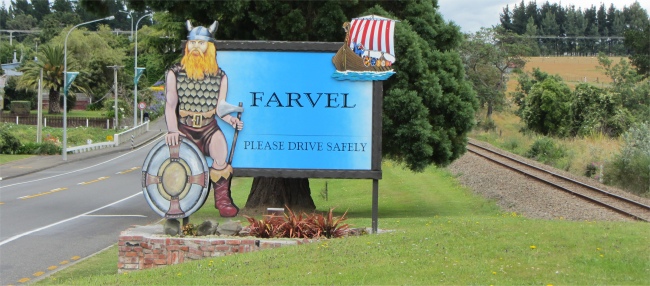 Farvel Dannevirke - Road and Rail Route Included |
Back on to the SH2. The road I had been driving on did not exist at the start of the 1870s. Indeed there was no land link between the port of Napier on the east coast and Wellington. The government needed a road opening up through this territory that was densely forested. So, it sent an emissary to Scandinavia with instructions to hire married men to build such a road. As an encouragement, each family would be granted 40 acres. The emissary returned with 13 Danish and 8 Norwegian families brought out under the Vogel Immigration Scheme. The government was wise to insist on married men since they would be less likely to sling their hook. The European settlement of Dannevirke began on 15 October 1872. The wives and families were effectively held hostage in Napier until the job was completed. The job did get completed, and the settlement that the workers were based in was honoured with the name Dannevirke, meaning "Danish work".
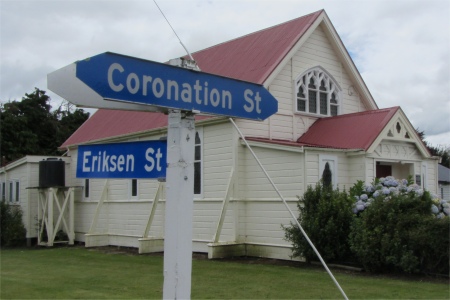 Conflicting Street Names in Norsewood |
Dannevirke's Scandinavian heritage remained today but perhaps to a lesser extent than it deserved. Street names of the era, such as Hamlet, Thyra, and Christian Streets, were constant reminders. Cemeteries were now of considerable historical importance, and the "Settlers Cemetery" attracted many visitors.
I visited the town's museum which was based in the old court house. The curator was busy outside with his electric drill, but greeted me cheerily and asked me to shout out if I needed any help with anything. As you would expect, the museum had an appreciable number of photographs and artefacts related to its timber milling activities in the past, plus countless references back to Scandinavia. Ship's listings of all the passengers who came across hung proudly on a wall.
The old curator periodically came to check if I needed any questions answering, but more to have a chat really. His grandparents had moved to Dunedin from Scotland, and he grew up in that "Scottish" city. He married a girl from Dannevirke. "My wife always wanted to see if she could find a connection with those original settlers. One day she was in the museum, and she saw these lists of names on the wall," he said, proudly pointing to the long lists, "and she found a 6 month old girl, who turned out to be my wife's grandmother."
 Norsewood School Sign |
Like many museums, it had to survive on donations, and it had only just managed to purchase the building it was now housed in. The lack of money for museums is a hard fact of life. Even harder was finding volunteers. They were mainly old people who are sadly becoming scarcer as time marches on.
I thanked the chap, and he shook hands enthusiastically, and made sure I filled in his visitors book.
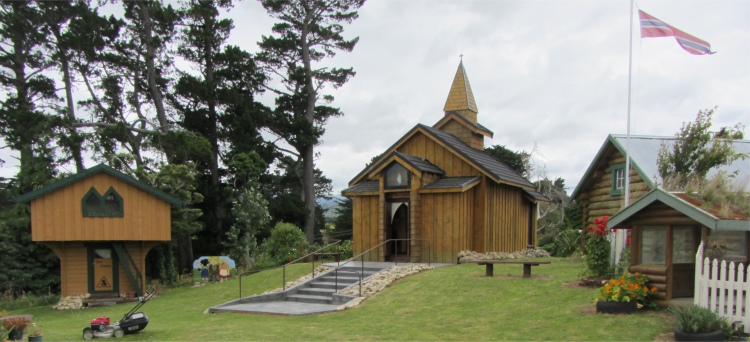 Johanna's World - Left to Right at the Back: Trollheimen, Maria Stavkirke, Pasotorpet |
Prior to 23rd September 1872, Norsewood did not exist. This area was uninhabited, and like Dannevirke, covered by extremely dense bush, dissected only by walking tracks.
The Government Plan under Julius Vogel purchased this land from the Maori. It was later known as the "70 Mile Bush" and the Government set about assisting suitable immigrants to tame it as the bush was obstructing progress in linking the Hawkes Bay to the Manawatu. It was agreed by Dr. Isaac Featherstone, New Zealand's first Agent General in London and Bror Friberg, appointed Government recruitment in Scandinavia, that the most suitable immigrants would be Scandinavians who were experienced farmers and woodsmen accustomed to frugal living and hardships.
On 23rd September 1872, the barque "Hovding" berthed at Napier carrying predominantly Norwegians, and some Swedes and Danes. The men set off and arrived at a natural clearing on Kopua Road, to be allotted their new section, decide the name of the village, and then search out their properties in the hostile environment of their strange new country. They brought no riches but skills, determination, energy and abounding hope for the future.
So the story of Norsewood began. Forty-acre plots were balloted and the price of Forty pounds was paid off over time by working on forming roads, building railways and clearing the bush. All this required huge physical effort.
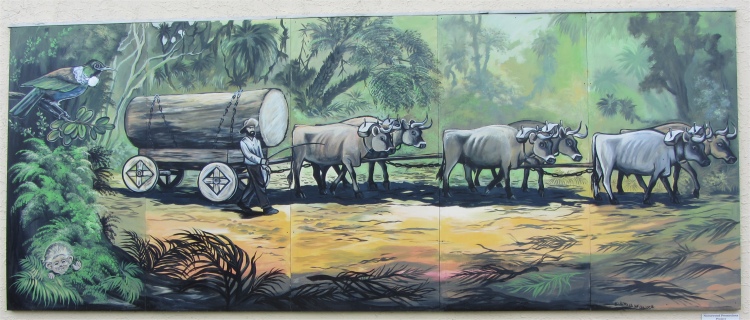 A Reminder of the Town's Origins |
Friberg, who with his family, had taken up a property in Garfield Road, played an important role in assisting the immigrants with their many needs and concerns during the first five years.
Huge hardships were experienced, all services were based in Waipawa and food was expensive. Illness, tragedy, bush fires and personal depression were all challenges faced. Through all this a unique community with all amenities was developed here.
The part of Norsewood that really intrigued me was Johanna's World, an early settler's memory park. I entered this small picket-fenced area and an interesting story unfolded. I walked across the grass to study the wooden buildings, and a stocky dark-skinned woman, who had been cutting grass with a sickle, came across to greet me.
"Hello, where are you from?" she asked. "England," I replied. "I'm originally from Fiji," she said, "and I married a Norwegian, Oystein (Stan) Andresen. He was a journalist and also a writer. He wrote six non-fiction books before he wrote Johanna's World. Have you read this book?" she asked me. She immediately noticed the blank look on my face, and saved me fumbling about for words by quickly adding, "Johanna was a girl when she came across with the early settlers. My husband got the entire story first hand from her when she was in her nineties. We moved to New Zealand, where a friend translated the book from Norwegian to English. As well as the book telling the story, my husband wanted to create this memory park, and named it Johanna's World. With the help of friends, we built it up out of timber to match actual buildings in Norway. Sadly my husband died a year ago. He is burried over amongst the trees there."
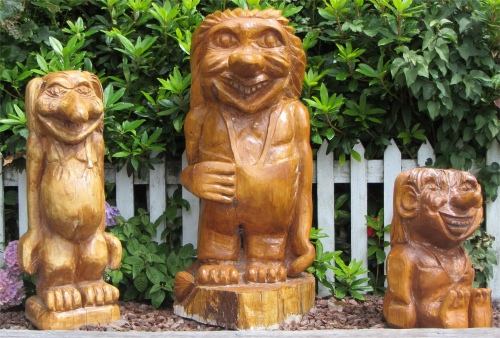 Norsewood Hooligan Trolls |
The lady, named Maria, left me to have a look around the small compound. Pride of place was Maria Stavkirke (Mary's Chapel). It is the first and only replica in New Zealand of an ancient Stave Church from Norway. It was available for weddings and other services. Nearby was Trollheimen, a Stabbur or ancient Norwegian storehouse. Now it was used for backpackers on the ground floor, and Troll Caves - playrooms for children on the first floor. On the opposite side of the church was Pasotorpet, a replica of the log cottage left by Johanna and her family in Norway in 1873. Also close at hand was Ingeborgbu, a family cottage where Maria lived and guests stayed.
In Pasotorpet, beds were made up as they would have been all those years ago, and a collection of Norwegian books stood shoulder to shoulder along a set of shelves. Amongst the books, I found a copy of Johanna's World. I sat and started to read it, but I thought this is no good, I'll be here all day.
After making a contribution in the troll box, I went off to find Maria and thank her for sharing this memory and small park with me. She was engaged elsewhere, but the two old Norwegian women were still out and about fixing things. "Mange Takk, Farvel," I said in my best Scandinavian accent. Sadly my knowledge is minimal, but I can say the pleasantries. "You are welcome," they replied, and as I was walking away, one ran after me and asked, "Excuse me, are you Norwegian?" "No, I'm English," was my response. "No, you are Norwegian. You speak Norwegian," she said earnestly. I explained I was English again, but also told her how my native Cumbrian was closely aligned with the Scandinavian tongue, and how expressions I had used when I was a child were pure Scandinavian. "It is probably due to the Viking invasions," I told her. "They were wicked, the Vikings, very wicked," she told me. She was surprised that such expressions still remained in parts of England, mind you so am I, but they do. We talked at length on the matter before I left them and carried on along the highway to my destination.
I felt for Maria who was obviously still grieving. It was a wonderful idea to construct a memory park to follow up on the book, Johanna's World. It would also serve as a memory towards her late husband. It took my mind back to the memory book that my wife was dictating in the final stages of her life. Sadly she faded quickly before it was completed. I was happy for Maria that she had this park on her door step.
Me and my waggon whistled through mind numbing sheep country, giving way to orchards and vineyards, bypassing Hastings, and on to Napier.
